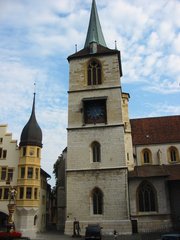Biel/Bienne
|
|
Template:Dablink Template:Infobox Swiss town
Biel/Bienne is a town in the Canton of Bern in Switzerland. It is located on the language boundary and is throughout bilingual. Biel is the German name for the town, Bienne its French counterpart. The town is often referred to in both languages simultaneously. Since January 1, 2005, the official name is "Biel/Bienne".
The town is located in the north eastern shores of Lake Biel (Bielersee). The city of Bern lies southeast of Biel/Bienne (30 minutes by train). The origin of the town has been traced to the times when Celts settled in the region. At the time it was called Belenus, after a Celtic deity. The Romans later inhabited the area. The town itself was built in the 11th century, and in 1275 it was chartered.
Biel/Bienne was under the jurisdiction of the Bishop of Basel for hundreds of years. In 1279 the town entered an alliance with Bern which was made permanent in 1352. There have been several conflicts between the inhabitants of Biel/Bienne and the Bishop of Basel. In 1798 Biel/Bienne was invaded by French troops. After Napoleon's collapse, the town became a part of the Canton of Bern, in 1815.
About two thirds of the population speak German, about one third French. The town is officially bilingual (it is the biggest bilingual town in Switzerland). Some 150 nationalities are represented in Biel/Bienne. In recent years the town has used its bilingualism as an economic advantage. Several call centres are located in or around Biel to make use of the two languages. The main industries of the town, however, are watchmaking and the manufacture of machinery.
The town centre of Biel/Bienne features a Gothic church which dates from 1451. The town hall dates from 1534. The population is an estimated 51,900.

